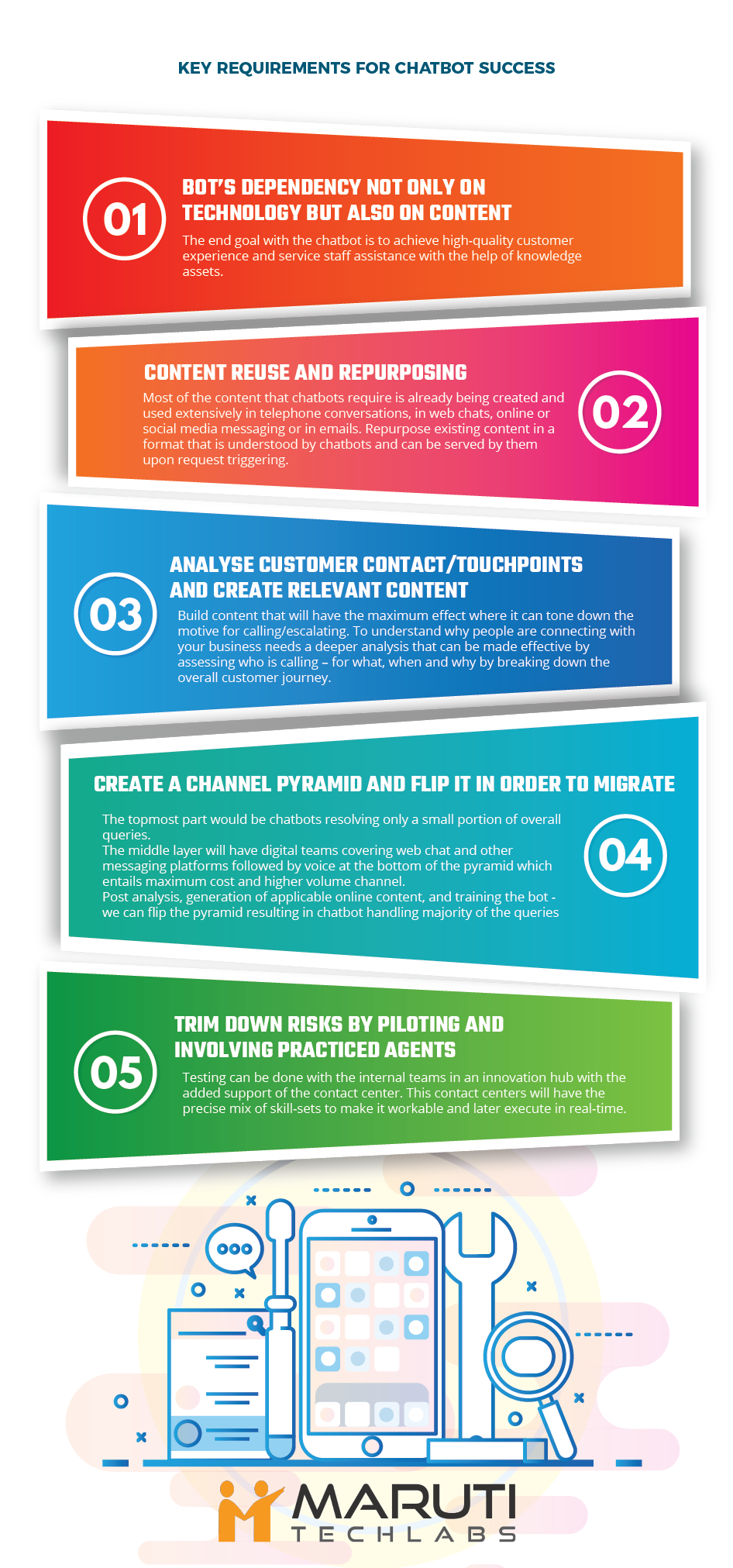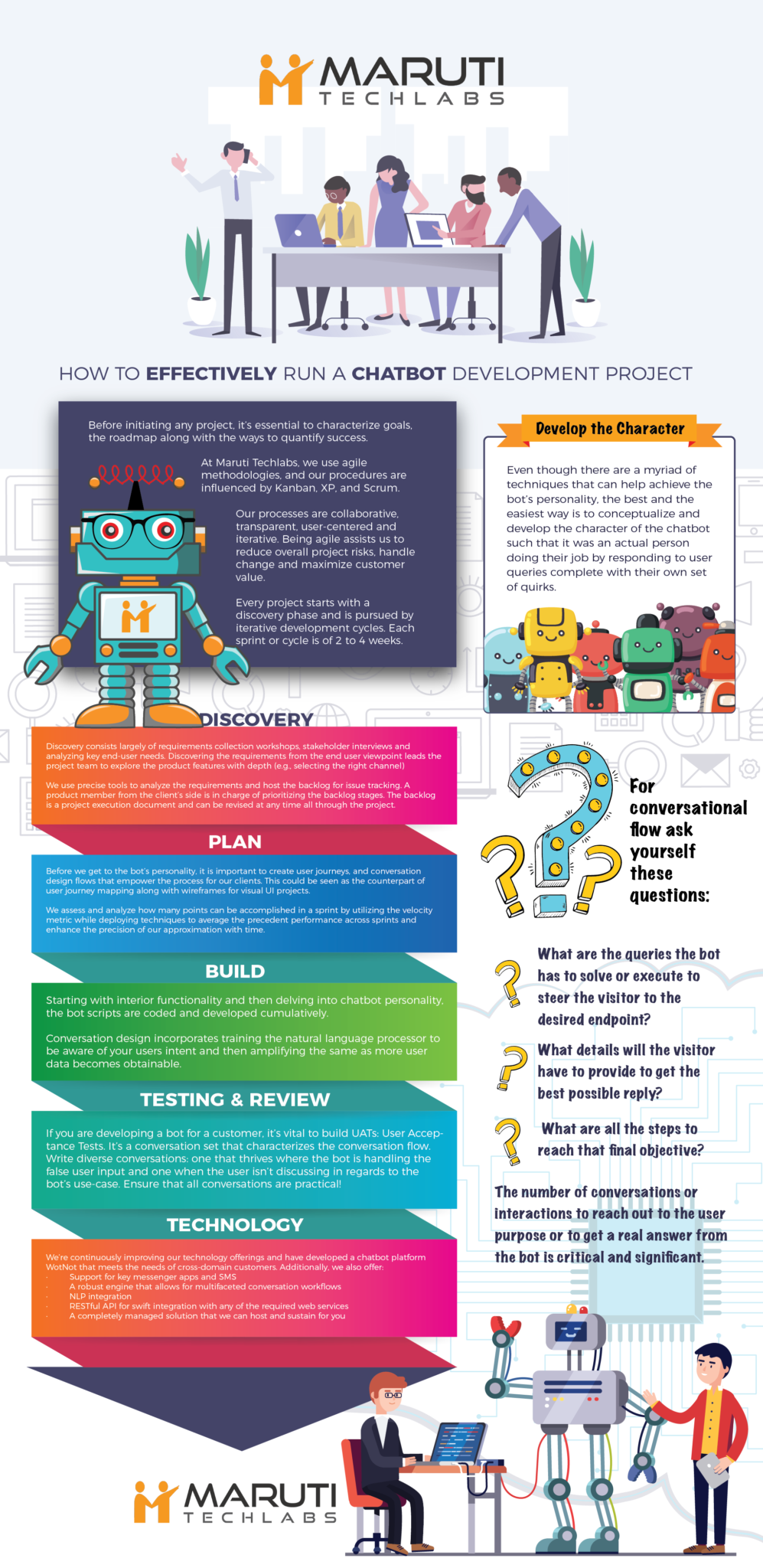How to Effectively Run a Chatbot Development Project?
In our last story, we went over the 7 key factors to consider before choosing a Chatbot Development Platform. Between selecting a particular use-case, choosing a platform, developing and finally deploying a functional bot — there’s a lot more than what meets the eye.
This article aims to uncover more around the key factors that determine the chatbot success along with the entire development process.
Key Requirements for Chatbot Development Success


Chatbots do not solely depend on technology but also on the content
The end goal with the chatbot is to achieve high-quality customer experience and service staff assistance. The noticeable element of chatbots is obviously the technology. However, content plays an important part in its success as well. Creating knowledge assets is a noteworthy investment, but in the shadow of high-end technology components like Artificial Intelligence (AI), the important role of content creation and curation often gets overshadowed.
Content reuse and repurposing
Most of the content that chatbots require is already being created and used extensively by customer service teams, be it in telephone conversations, in web chats, online or social media messaging or in emails. Re-purposing this existing content is in a format that is understood by chatbots and can be served by them upon request triggering.
The goal should be to generate the content once and reuse after that. Accomplishing this needs close links between whoever is curating the content which can be your service teams and the digital marketing department.
Analyse customer touchpoints to create relevant content
The commencing point is to build content that will have the maximum effect — where content can tone down the motive for calling, and the volume of calls is higher. To understand why people are connecting with your business needs a deeper analysis that can be made effective by assessing who is calling — for what, when and why, breaking down the overall customer journey, testing of contacts across channels and research activities like customer surveys, online as well as offline conversations and e-mail content.
Create a channel pyramid and flip it in order to migrate
While creating a channel pyramid, at the topmost part would be the chatbots. In the beginning, these would resolve only a small portion of overall queries, acting as a preliminary step or an online IVR and directing customers to the digital teams who are more suitable to manage the interactions.
The digital teams will cover web chat and messaging platforms as the center layer, assisting the migration to the digital conversation which is lower in cost as compared to voice at the absolute bottom of the pyramid which entails maximum cost and higher volume channel.
Using all the analysis carried out and the generation of applicable online content, we can then flip the pyramid with chatbots dealing with more and more complex queries — final objective being that they will manage the majority of the cases shortly.
Trim down risks by piloting and involving practiced agents
Chatbots are not readily developed technology tools, so the risk of a deprived experience is something one must take into consideration. A few forms of AI can be tested with the internal teams rather than direct exposure to the customers or prospects. It would be prudent to locate these trials in an innovation hub with the added support of the contact center. This contact centers will have the precise mix of skill-sets to make it workable and later try in real-time.
How to build a bot with a chatbot development company?
Before initiating any project, it’s essential to characterize goals & the roadmap along with the ways to quantify success.
At Maruti Techlabs, being a chatbot development company, we use agile methodologies, and our procedures are influenced by Kanban, XP, and Scrum. We customize our processes for the different projects and customers that we work with.
Our processes are collaborative, transparent, user-centered and iterative. Being agile assists us to reduce overall project risks, handle change and maximize customer value.
How does the chatbot development process work?
Every project starts with a discovery phase and is pursued by iterative development cycles. Each sprint or cycle is of 2 to 4 weeks.
Discovery
The discovery phase is undertaken at the commencement of the chatbot development project. It consists largely of requirements collection workshops, stakeholder interviews and analyzing key end-user needs. The backlog is the prime output of this phase with recognized requirements written as ‘user stories’. Identifying the use-case and type they’re looking for (sequential bot or NLP based) helps in listing out the various intents and actions that are to be carried out the chatbot. Discovering the requirements from the end user viewpoint leads the project team to explore the product features with depth.
For example, selecting the precise messaging platform (Facebook Messenger, Slack or your Website) is the key point of the discovery phase. Ultimately the preference should be focused as per your target audience, and you need to meet them where they are.
We use precise tools to analyze the requirements and host the backlog for issue tracking. A product member from the client’s side is in charge of prioritizing the backlog stages. The backlog is a project execution document and can be revised at any time all through the project.
Plan
Before we get to the bot’s personality, it is important to create user journeys, and conversation design flows that empower the process for our clients. This could be seen as the counterpart of user journey mapping along with wireframes for visual UI projects.
For conversational flow ask yourself these questions:
- What are the queries the bot has to solve or execute to steer the visitor to the desired endpoint?
- What details will the visitor have to provide to get the best possible reply?
- What are all the steps to reach that final objective?
The number of conversations or interactions required in order to reach out and satisfy the user’s purpose is critical and significant.
Even though there are a myriad of techniques that can help achieve the bot’s personality, the best and the easiest way is to conceptualize and develop the character of the AI chatbot such that it was an actual person doing their job by responding to user queries complete with their own set of quirks.
Coming back to the sprint, at the opening of every sprint, we conduct a ‘Sprint Planning’ session. The entire team attends the Sprint Planning meeting, and it is where we go through the utmost priority stories in the backlog, state them in detail, plan the tasks and assess them. Every user story is given an approval criteria to be considered as completed.
We assess and analyze how many points can be accomplished in a sprint by utilizing the velocity metric while deploying techniques to average the precedent performance across sprints and enhance the precision of our approximation with time.


Build
We intend to build and deliver a working product which is ready to use by actual users. The thought is to then iterate on this product, accumulating more features until we start off to meet the objectives we set out right at the initial stages.
Starting with interior functionality and then delving into chatbot personality, the bot scripts are coded and developed cumulatively.
Conversation design incorporates training the natural language processor to be aware of your users intent and then amplifying the same as more user data becomes obtainable.
Testing and Review
If you are developing a bot for a customer, it’s vital to build UATs: User Acceptance Tests. It’s a conversation set that characterizes the conversation flow. Write diverse conversations: one that thrives where the bot is handling the false user input and one when the user isn’t discussing in regards to the bot’s use-case. Ensure that all conversations are practical!
At the end of every sprint, we conduct a demo. We run across all the created user stories and try to display its implemented process. The product owner who is from the client’s team reviews and decides whether to allow the implementation on the basis of the determined criteria.
If the user story is 100% accepted, it is given the status as done.
Technology
We’re continuously improving our technology offerings and have developed a chatbot platform that meets the needs of cross-domain customers. Additionally, we also offer:
- Support for key messenger apps and SMS
- A robust engine that allows for multifaceted conversation workflows
- NLP integration
- RESTful API for swift integration with any of the required web services
- A completely managed solution that we can host and sustain for you
Conclusion
Chatbots are not exactly different from other applications; you have multiple integrations that back the application, with the involvement of all the diverse dynamics. Given that a chatbot is needed to engage rapidly with an end-user, it requires being clear whether the information offered by the different integrations, are critical for the conversation or can be deferred until a later moment. Consistency in the integrations through APIs not only assists the agility but also helps in creating perfect conversations.
Customers today are more insistent than ever, with higher expectations and lower tolerance. A chatbot solution can assist you in meeting those expectations, however, every enterprise doesn’t have the time or resources to come up with a solution that is tailored to their core business — trained and deployable in just a couple weeks time.
At Maruti Techlabs, we offer end-to-end chatbot development services and assist enterprises & brands in streamlining the way they interact with customers. We deploy highly intelligent, sophisticated and scalable chatbot solutions across multiple domains such as Finance, E-Commerce, Real Estate and Insurance to name a few.
Being well-versed in AI, NLP and ML, we provide bot solutions, customized to your requirements, across multiple different channels (Facebook, Twitter, Slack, Telegram, Website or your enterprise’s Intranet). Get in touch with us today to deploy bots that fit your business specific needs while matching your brand’s voice and tone.
Read the FULL article on ‘How to Plan Chatbot Development at an Enterprise Level’ here — https://www.marutitech.com/chatbot-development/
